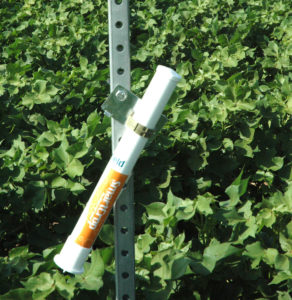‘Internet of things’ to create big data for irrigated agriculture
Writer: Kay Ledbetter, 806-677-5608, [email protected]
Contact: Dr. Charles Hillyer, 806-677-5600, [email protected]
AMARILLO – Big data is big business, and everyone wants a part of the pie, however agricultural irrigators should take a careful look before accepting irrigation advice from new technology sources, according to a Texas A&M AgriLife Extension Service specialist.

Dr. Charles Hillyer, AgriLife Extension irrigation specialist in Amarillo, said a recent survey on emerging irrigation technologies identified the “internet of things” or IoT as the most important issue.
What is that? Big data, Hillyer said.
“Most mentioned by the survey takers is having lots of devices being used by irrigators communicating with each other so collectively the products can do more than individually,” he said.
“There are dozens of startups offering products, but it is surprising who is doing it,” Hillyer said. “Are you ready to get irrigation advice from your cell phone company?”
He said IoT products are based on a communication chain. The chain starts in the field, usually with many inexpensive sensors. The chain goes to the cloud where the data is stored, analyzed and transformed into useful information.
The chain ends back in the field, either on the producer’s cell phone where he or she sees the field in a new way, or it ends at another IoT device that uses the new information to control valves, pumps or other smart devices, Hillyer said.
“Basically, it’s the process of taking data from one device, sending it to the cloud and then back to you as useful information rather than just data,” Hillyer said.
The final part is analytics – taking all the data and deriving new information from that data, he said.
“This is where big data comes into play. By having more data, and by receiving it more frequently, data scientists can apply sophisticated algorithms that reveal patterns and trends no individual sensor can reveal,” Hillyer said.
“It’s not just one of these steps, it’s the whole process of getting all this to work together – that’s the basis of IoT,” he said. “The idea is to make it easier to base decisions on data rather than intuition. But it will be new, something you are not accustomed to.”
Concerns pointed out by the survey takers were power supply, security and hardware compatibility, Hillyer said. Every new product should be analyzed for its ability to address these issues.
Some battery-powered devices don’t last as long as might be expected, he said. Typically, manufacturers estimate battery life based on how often the device will communicate with the cloud. But consumers often want more frequent communication, especially when the devices are first installed.
Security is also a concern, Hillyer said.
“The IoT devices are constantly streaming data to the cloud, and while the cloud may have good security, the devices may not,” he said. “Some early IoT solutions got a bad rap because the devices themselves could be hacked. So that is one of the first questions you should ask – what about security? Find out what the manufacturer does to protect the information both in the field and in the cloud.
“Then consider compatibility,” Hillyer said. “Be careful that the integrators are selecting compatible hardware so damage is not done. Some IoT vendors are vertically integrated: they provide all the hardware, connectivity, and cloud services. Other vendors are sourcing hardware from third parties.”
Hillyer said distributed sensor networks have a greater density of information. Having more information, and receiving it sooner, means producers can do things more accurately and more precisely.
Some products will offer other services such as analytics, off-farm integration and supply chain management. These data have value and some companies will want to aggregate the data and sell it to third parties.
“If you are looking at one of these services, be sure you know where your data is going.” Hillyer said.
Most IoT companies will say the producer owns the data but that doesn’t always mean the company can’t derive more value from the data, he said.
“If folks start showing up to offer you IoT products, ask questions,” Hillyer warned. “Many will be offering service, but may not be selling the hardware. When you look at the product, be sure you understand what exactly you are paying for. Sometimes you are buying hardware and sometimes you are buying a service.”
Know where the data is going to be stored – “your cloud or their cloud. Can the data be exported or are you limited by where you can look at it, thus limiting your use?”
And, he said, know who is in the connectivity chain.
“IoT vendors don’t always make each element in the connectivity chain, they are doing the integration,” Hillyer said. “Are they doing a full integration or are they reselling parts and packaging them together? A full product is going to be better integrated. “
Also find out what is offered in the way of support, he advised.
“These sensors are predicated on being small and expensive. Some are going to break. Who supports it? If one company makes everything, there is only one place to go,” Hillyer said.
“Producers need to know and understand how IoT solutions increase their accuracy,” he said. “Is the new information something you can act on or is it just informative? Can you make calculations based on the information? Are the data actual measurements or modeled information?”
Getting answers to these questions will help producers decide if an IoT product will actually help their management or just add to the avalanche of data they are already receiving, he said.


